Introduction
In the digital age, organizations are inundated with vast amounts of data, and managing this information efficiently is paramount for success. Intelligent Document Processing (IDP) emerges as a transformative solution, harnessing the power of artificial intelligence to automate and enhance the way businesses handle documents. By streamlining data extraction, classification, and processing, IDP not only addresses the inefficiencies of traditional methods but also empowers organizations to adapt quickly to changing market demands.
This article delves into the nuances of IDP, offering insights into its benefits, key considerations for selecting the right software, and real-world applications across various industries. As companies strive for operational excellence, understanding and implementing IDP can pave the way for increased efficiency, accuracy, and ultimately, growth.
Understanding Intelligent Document Processing (IDP)
Intelligent Document Processing (IDP) represents a substantial advancement in how organizations manage their information. By utilizing the capabilities of artificial intelligence, IDP automates the extraction, classification, and processing of information from a wide variety of documents, effectively addressing the challenges presented by outdated systems that impede efficiency and innovation. This advanced technology transcends traditional processing methods reliant on manual input, utilizing machine learning and natural language processing to intelligently interpret and comprehend information. Gartner’s acknowledgment of UiPath as a frontrunner in process mining platforms in 2024 highlights IDP’s increasing importance in the sector.
Consequently, companies can skillfully manage diverse formats—from scanned images and PDFs to emails—while attaining significant improvements in accuracy and efficiency. For instance, UiPath highlights successful IDP implementations, such as:
- Future-proofing invoicing and billing processes for a UK water utility
- Transforming incoming legal operations for a major global telecom
Moreover, by integrating Business Intelligence, organizations can transform this data into actionable insights, enabling informed decision-making that drives growth and innovation. By streamlining workflows, IDP empowers businesses to pivot swiftly in response to evolving market demands, allowing them to concentrate on strategic growth initiatives. Combined with RPA tools such as EMMA RPA and Microsoft Power Automate, this method boosts productivity and employee morale, driving significant improvements while tackling the challenges of the swiftly changing AI landscape.
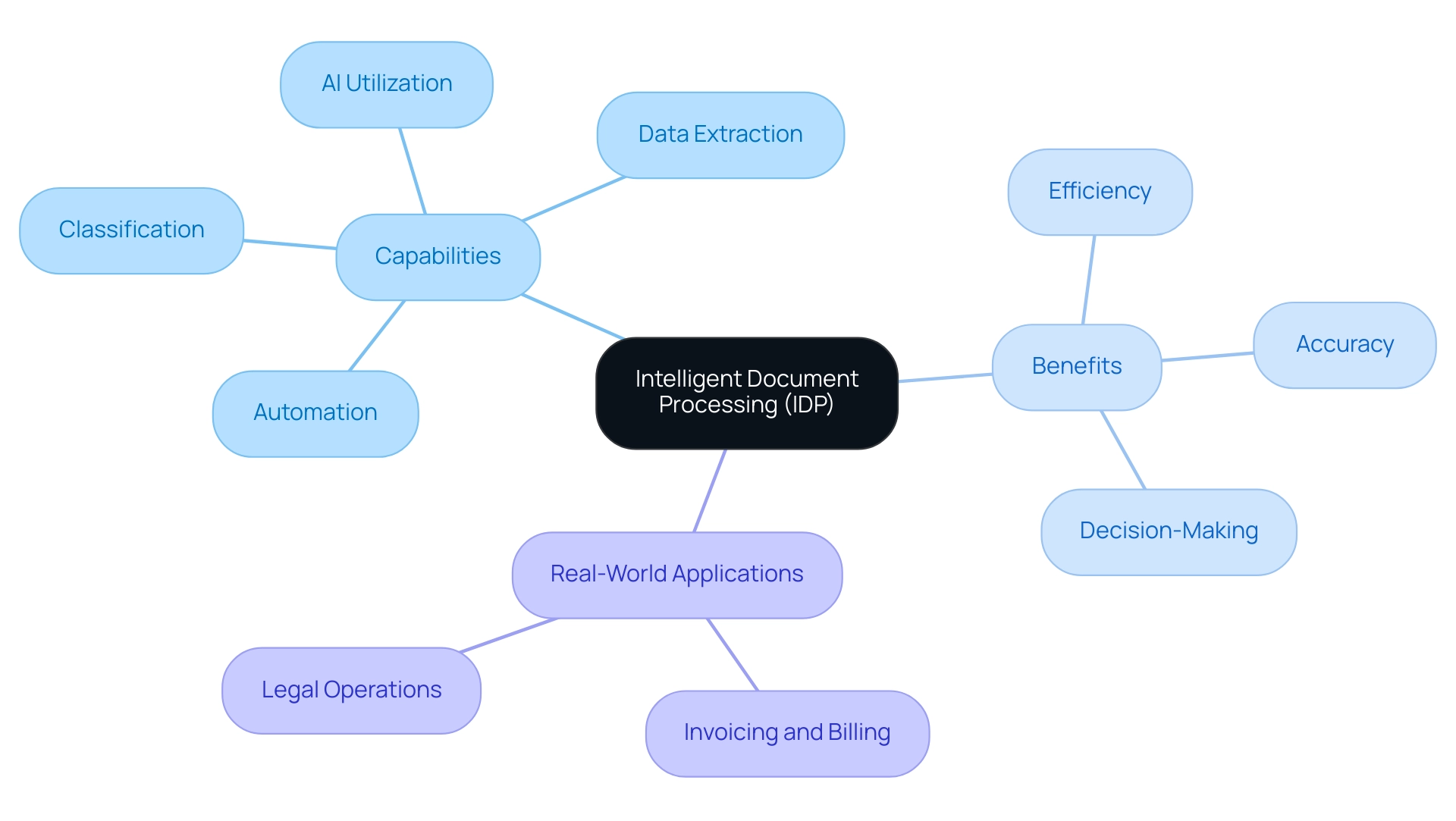
Key Considerations for Selecting IDP Software
Choosing the appropriate Intelligent Document Processing (IDP) software is a crucial decision that can greatly influence your efficiency. Here are key factors to consider in 2024:
- Scalability: Choose a solution that can adapt and grow in tandem with your business needs, ensuring it remains effective as your operations expand.
- Integration: It’s essential to select software that seamlessly integrates with your current systems and workflows, minimizing disruption and enhancing efficiency right from the start. Leveraging Robotic Process Automation (RPA) in conjunction with your IDP can further streamline these processes.
- User Experience: Opt for software that features an intuitive interface. This will reduce the time and resources needed for training, allowing your team to become productive quickly.
- Information Security: Considering the sensitive nature of the information processed, it’s critical to thoroughly evaluate the security measures the software employs to protect your information.
- Vendor Support: Assess the level of support provided by the vendor, which is crucial for successful implementation and ongoing troubleshooting.
Additionally, consider the recent launch of the Intelligent Document Processing Vendor Directory, which offers easy access to various IDP solutions, helping you make informed choices by providing insights into how these solutions can address specific challenges in the evolving AI landscape.
As Jim Chase, Executive Chairman at Celaton, states, ‘Celaton naturally aligns with ADVT’s focus of empowering customers by streamlining complexities, automating repetitive tasks, and ultimately enhancing productivity, compliance, and engagement.’ This highlights the significance of choosing software that not only satisfies immediate requirements but also aids in achieving long-term objectives.
Furthermore, leveraging tailored AI solutions and Business Intelligence is essential for transforming raw data into actionable insights, enabling informed decision-making that drives growth and innovation. The recognition of ABBYY, Mindee, and Evolution AI at the 2024 AI Breakthrough Awards highlights successful integration of IDP solutions, providing real-world examples of excellence in the field.
By leveraging RPA, tailored AI solutions, and Business Intelligence along with these considerations, you can identify an IDP solution that not only meets your immediate functional requirements but also positions your organization for future success in a rapidly evolving digital landscape.
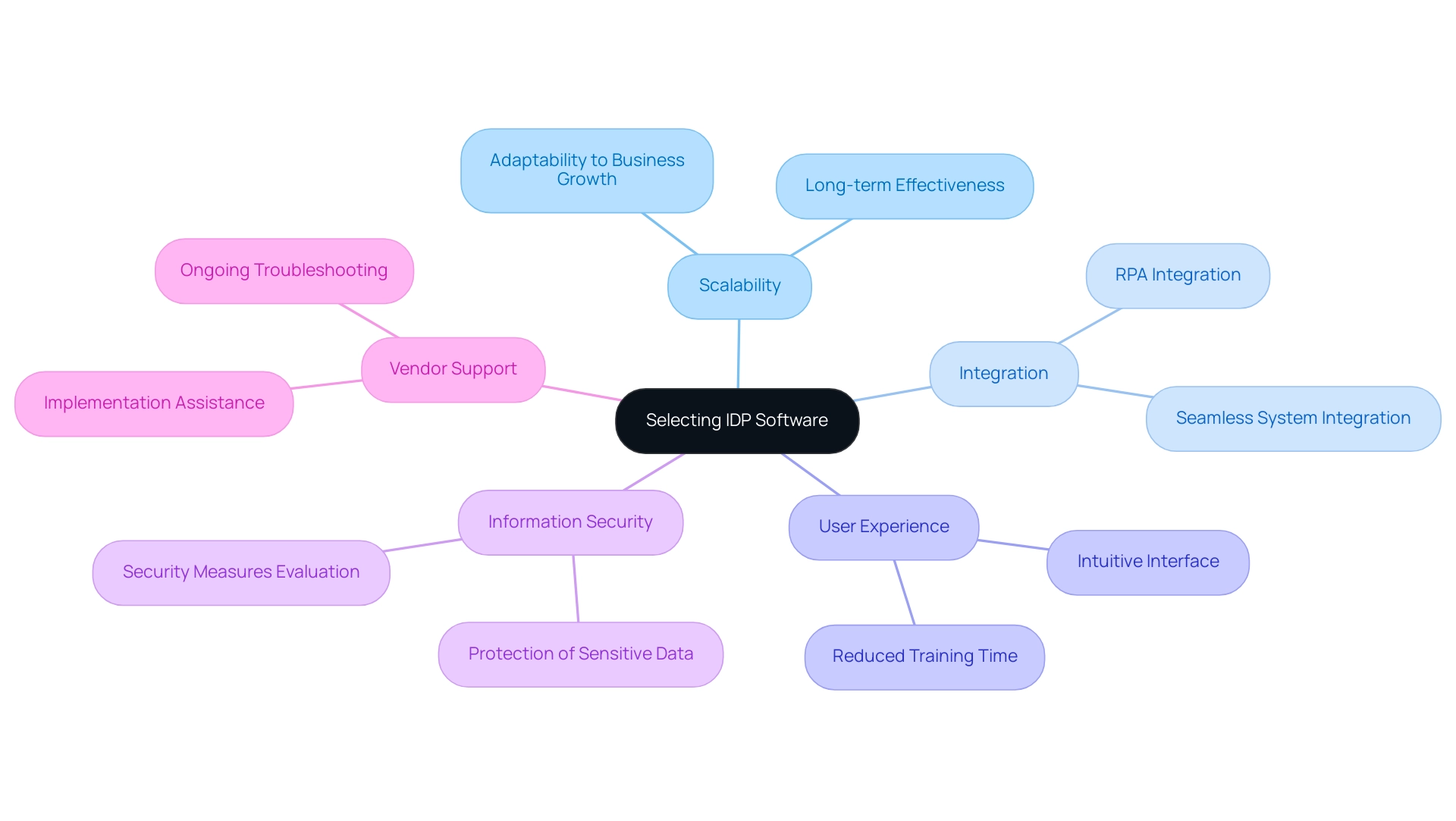
Benefits of Implementing Intelligent Document Processing
Implementing Intelligent Document Processing (IDP) offers a myriad of advantages that can significantly transform operational workflows. Key benefits include:
-
Increased Efficiency: Automation of document handling drastically reduces the time spent on manual information entry and processing tasks. For instance, entities that have adopted IDP report an average efficiency gain of 30-50%, enabling them to manage growing document volumes more effectively. This aligns with the outcomes from recent case studies where implementing Robotic Process Automation (RPA) and GUI automation led to an 80% improvement in workflow efficiency.
-
Enhanced Accuracy: AI-driven solutions are crafted to reduce human mistakes, ensuring that quality is consistently high. This accuracy is vital for making informed decisions based on reliable information. According to industry experts, organizations utilizing IDP encounter a 90% reduction in entry errors, significantly enhancing decision-making processes.
-
Cost Savings: Streamlining workflows through IDP leads to substantial reductions in operational costs associated with document management. A recent case study showed that a financial institution saved over $200,000 annually after implementing IDP solutions, allowing them to allocate resources more effectively and achieve greater returns on investment. Likewise, a mid-sized firm adopting GUI automation decreased entry mistakes by 70% and sped up testing procedures by 50%, showcasing the financial advantages of automation.
-
Better Compliance: IDP systems aid in upholding adherence to various regulatory requirements by providing comprehensive audit trails and secure information handling processes. This capability is increasingly critical in today’s regulated business environment.
-
Scalability: As companies expand, IDP systems can seamlessly adapt to handle increased document volumes without the need for significant additional resources, ensuring that operational efficiency is maintained.
However, entities often encounter challenges such as manual information entry errors, slow processing times, and difficulties in managing large volumes of documents before implementing IDP solutions. Embracing IDP not only enhances productivity but also positions organizations to navigate the complexities of modern document management with confidence, particularly in the rapidly evolving AI landscape.
As stated, Intelligent Document Processing (IDP) represents a groundbreaking approach to document management, utilizing advanced technologies to simplify the extraction and handling of information. This innovative technology is particularly relevant in the rapidly expanding IDP market, where sectors such as Banking, Financial Services, and Insurance (BFSI) are expected to account for over 30% of the total IDP market by 2025. Furthermore, integrating tailored AI solutions can further enhance the effectiveness of IDP by providing targeted insights and analytics that drive informed decision-making.
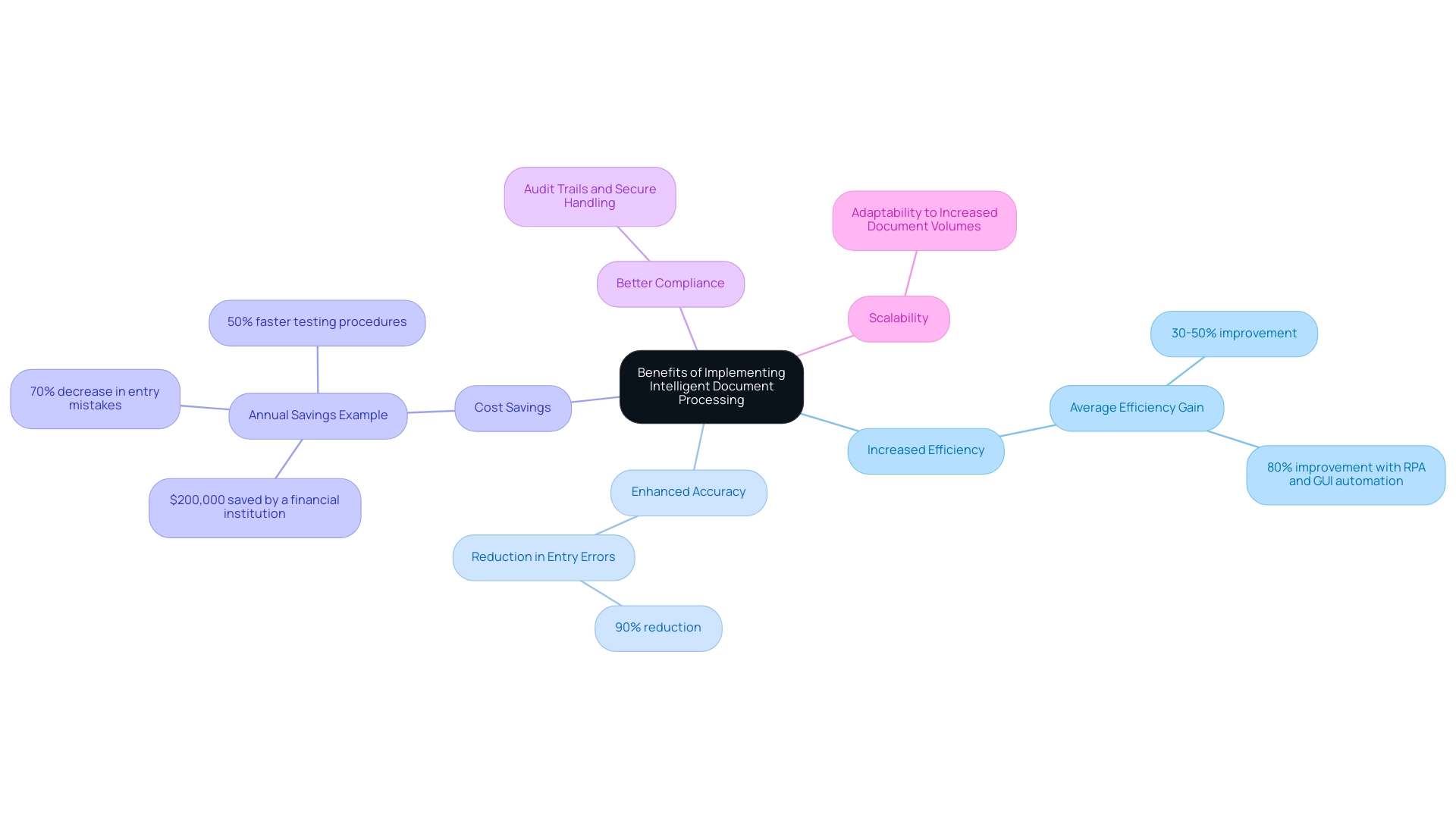
IDP vs. Traditional Document Processing: Key Differences
Understanding the distinctions between Intelligent Document Processing (IDP) and traditional document processing is crucial for transforming operational efficiency through automation. Key differences include:
-
Automation: IDP excels in automating information extraction and classification, significantly reducing the manual intervention that characterizes traditional methods. With industry reports projecting automation rates in document processing to reach 75% by 2024, organizations can increasingly rely on IDP technologies. This capability not only accelerates processing times but also minimizes human error, fostering more reliable information management and enhancing employee morale. Moreover, when integrated with RPA tools like EMMA RPA and Microsoft Power Automate, IDP can further streamline workflows and boost overall operational efficiency.
-
Flexibility: Unlike traditional systems that struggle with unstructured information, IDP is designed to seamlessly handle various document types and formats. This adaptability ensures that entities can manage diverse information sources without extensive reconfiguration, making it an ideal solution in a rapidly evolving AI landscape.
-
Learning Capabilities: One standout feature of IDP is its machine learning capability, enabling the system to evolve and improve its processing over time. This contrasts sharply with traditional systems, which are often static and unable to adapt to new document types or changing business requirements, thereby stifling innovation.
-
Integration: IDP solutions are engineered for seamless integration with other technological platforms, enhancing workflow efficiency. In contrast, traditional systems frequently operate in silos, complicating information flow and reducing overall productivity. This integration is essential for entities looking to modernize outdated systems and improve data quality.
As mentioned by a sector specialist, “The capacity of IDP to adjust and incorporate is a game changer for entities seeking to improve their efficiency in operations.” These differences emphasize the functional advantages of IDP and underscore its role in supporting emergency response efforts by streamlining information processing during crises. For example, a case study on fraud detection in the public sector illustrates how IDP analyzes documents for inconsistencies, leading to enhanced fraud detection in areas like tax administration. Additionally, by utilizing IDP alongside RPA, organizations can ensure that they are not only improving efficiency but also gaining actionable insights that drive informed decision-making.
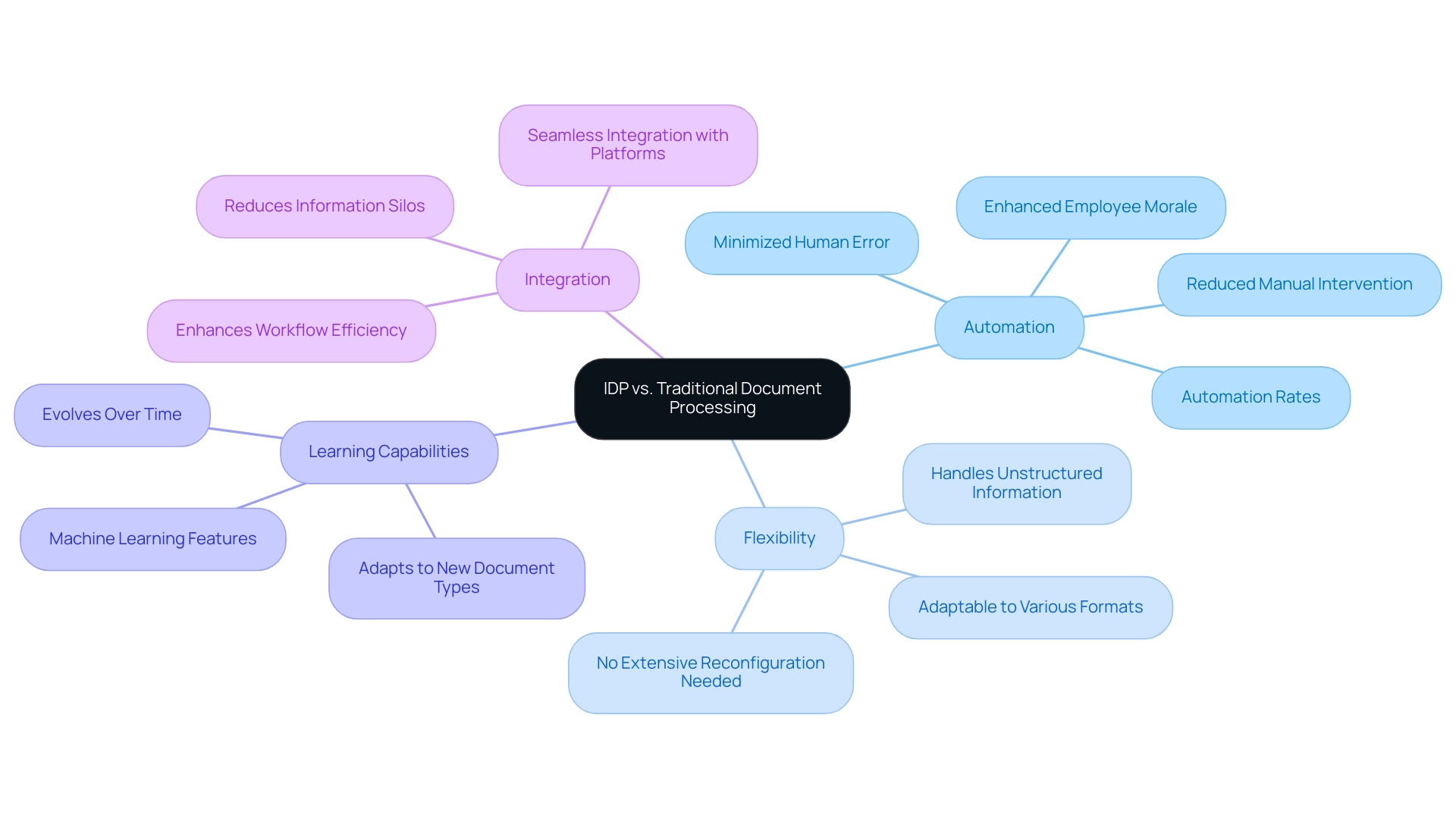
Real-World Applications of Intelligent Document Processing
Intelligent Document Processing (IDP) is making significant strides in enhancing operational efficiency across multiple sectors, particularly in healthcare. Here are some compelling applications:
-
Finance:
Financial institutions are increasingly adopting IDP to automate loan application processing, reducing turnaround times and significantly boosting customer satisfaction. For instance, Cox Automotive has successfully integrated systems from over 20 acquired companies using APIs, showcasing the power of streamlined processes, which has led to a 2.5x increase in project delivery speed. -
Healthcare:
In the healthcare sector, hospitals are leveraging IDP to efficiently manage patient records, facilitating swift access to critical information essential for timely care. The execution of GUI automation has tackled challenges such as manual input errors and slow software testing, resulting in a 70% decrease in entry mistakes and an 80% enhancement in workflow efficiency. Dr. Jane Smith, a healthcare expert, states, ‘The implementation of IDP in healthcare is a game-changer, allowing for more accurate data management and improved patient outcomes.’ -
Legal:
Law firms are utilizing IDP to expedite contract review processes. By automating this traditionally labor-intensive task, attorneys can focus on strategic initiatives rather than mundane paperwork. -
Insurance:
Insurance firms gain from IDP by handling claims at a significantly quicker pace, improving service delivery while simultaneously lowering costs. For example, the rapid launch of an IT structure by Sumitomo achieved in just six weeks exemplifies the advancements in document management with zero end-user interruption. Additionally, ASICS has launched a new eCommerce platform in just six months, reusing APIs to deliver IT projects 2.5x faster, further demonstrating the effectiveness of IDP.
These real-world applications emphasize IDP’s potential to transform document processing, enhancing efficiency and preparing entities for future growth. Furthermore, organizations often face challenges such as employee exhaustion from repetitive tasks, difficulties in attracting talent, and outdated systems that hinder innovation. By implementing IDP, these challenges can be mitigated, leading to improved operational outcomes and a significant ROI within six months.
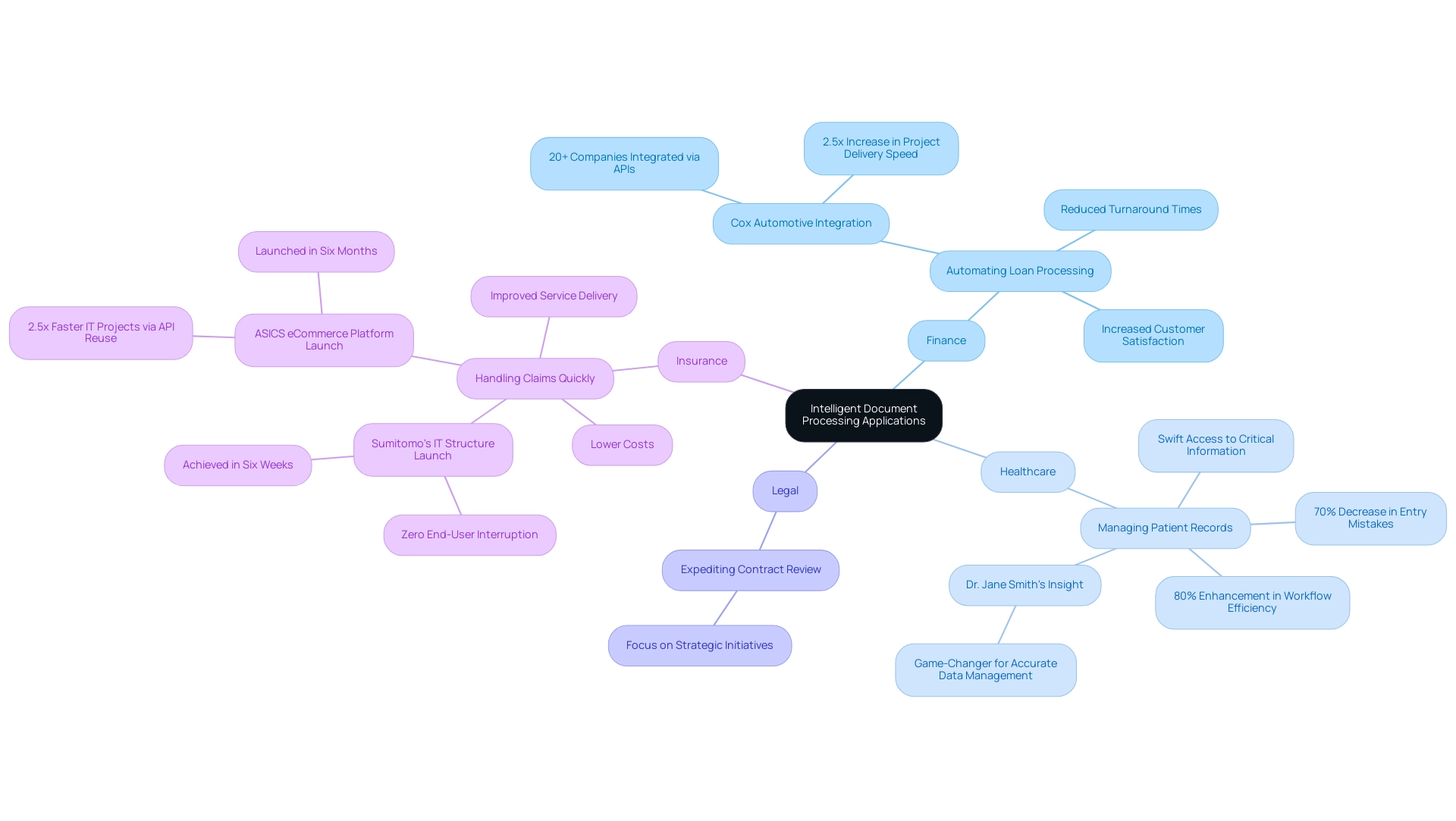
Conclusion
The implementation of Intelligent Document Processing (IDP) stands as a pivotal advancement for organizations navigating the complexities of the digital age. By automating the extraction, classification, and management of documents, IDP not only enhances operational efficiency but also significantly reduces the risk of human error. As highlighted, businesses leveraging IDP have reported substantial improvements in processing times and accuracy, which ultimately fosters better decision-making and compliance with regulatory standards.
Selecting the right IDP software is crucial, with considerations such as scalability, integration, user experience, data security, and vendor support playing a vital role in ensuring long-term success. The advancements in IDP technologies, coupled with the integration of Robotic Process Automation (RPA) and tailored AI solutions, create a powerful synergy that empowers organizations to streamline workflows and adapt to evolving market demands.
Real-world applications across various sectors, including finance, healthcare, legal, and insurance, demonstrate the transformative potential of IDP. By tackling traditional inefficiencies, IDP not only enhances productivity but also positions organizations to thrive in an increasingly competitive landscape. As the demand for agility and accuracy in document management continues to grow, embracing IDP can pave the way for sustainable growth and operational excellence.
Organizations that invest in this innovative technology will not only improve their current processes but also set a solid foundation for future advancements in their operations.

